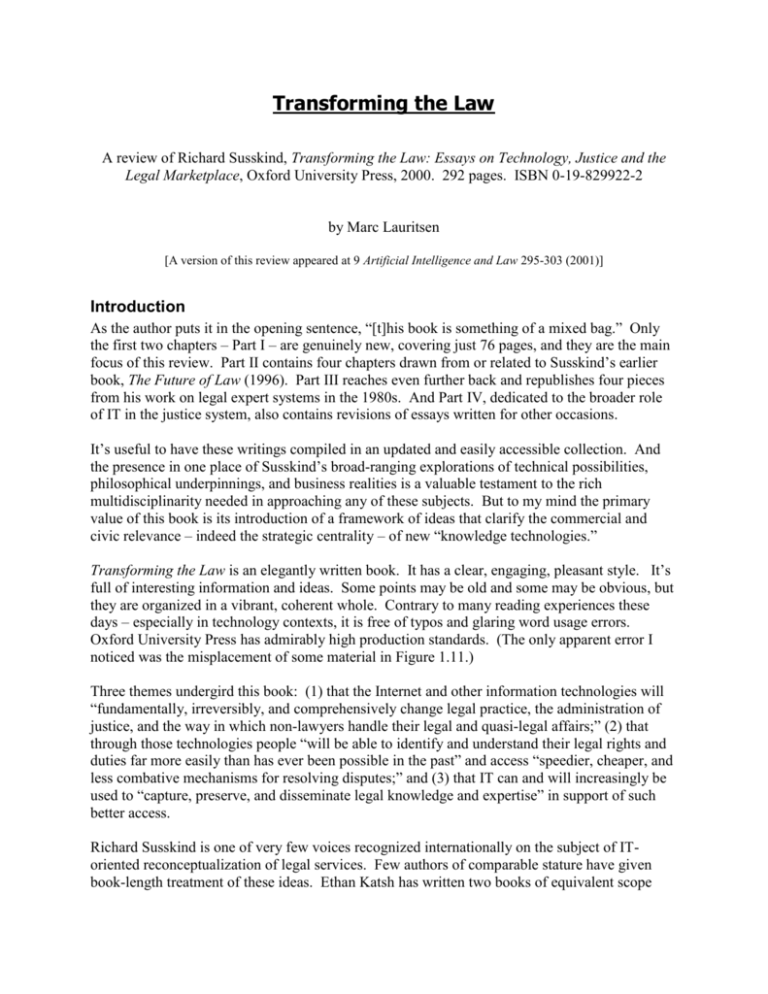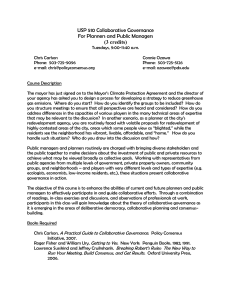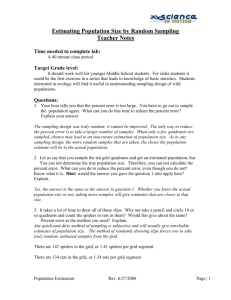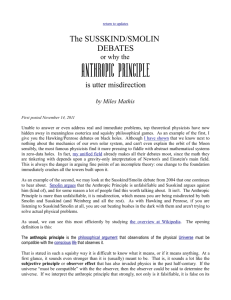Transforming the Law - Capstone Practice Systems
advertisement

Transforming the Law A review of Richard Susskind, Transforming the Law: Essays on Technology, Justice and the Legal Marketplace, Oxford University Press, 2000. 292 pages. ISBN 0-19-829922-2 by Marc Lauritsen [A version of this review appeared at 9 Artificial Intelligence and Law 295-303 (2001)] Introduction As the author puts it in the opening sentence, “[t]his book is something of a mixed bag.” Only the first two chapters – Part I – are genuinely new, covering just 76 pages, and they are the main focus of this review. Part II contains four chapters drawn from or related to Susskind’s earlier book, The Future of Law (1996). Part III reaches even further back and republishes four pieces from his work on legal expert systems in the 1980s. And Part IV, dedicated to the broader role of IT in the justice system, also contains revisions of essays written for other occasions. It’s useful to have these writings compiled in an updated and easily accessible collection. And the presence in one place of Susskind’s broad-ranging explorations of technical possibilities, philosophical underpinnings, and business realities is a valuable testament to the rich multidisciplinarity needed in approaching any of these subjects. But to my mind the primary value of this book is its introduction of a framework of ideas that clarify the commercial and civic relevance – indeed the strategic centrality – of new “knowledge technologies.” Transforming the Law is an elegantly written book. It has a clear, engaging, pleasant style. It’s full of interesting information and ideas. Some points may be old and some may be obvious, but they are organized in a vibrant, coherent whole. Contrary to many reading experiences these days – especially in technology contexts, it is free of typos and glaring word usage errors. Oxford University Press has admirably high production standards. (The only apparent error I noticed was the misplacement of some material in Figure 1.11.) Three themes undergird this book: (1) that the Internet and other information technologies will “fundamentally, irreversibly, and comprehensively change legal practice, the administration of justice, and the way in which non-lawyers handle their legal and quasi-legal affairs;” (2) that through those technologies people “will be able to identify and understand their legal rights and duties far more easily than has ever been possible in the past” and access “speedier, cheaper, and less combative mechanisms for resolving disputes;” and (3) that IT can and will increasingly be used to “capture, preserve, and disseminate legal knowledge and expertise” in support of such better access. Richard Susskind is one of very few voices recognized internationally on the subject of IToriented reconceptualization of legal services. Few authors of comparable stature have given book-length treatment of these ideas. Ethan Katsh has written two books of equivalent scope (1989 and 1995), which are more scholarly and intellectually adventurous, but less fitted for mainstream legal and business professionals. David Maister articulates many similar insights about the strategic importance of knowledge systems in professional services organizations (1997), but is less conversant with specific technologies or peculiarities of the legal domain. Others have championed similar ideas in short articles. See, e.g., Granat (1997), Hokkanen (1999) and Lauritsen (1990 and 2001). Let’s look more specifically at chapters 1 and 2, each of which revolves around a unifying model. The Grid I once heard a reasonably famous business speaker say “it’s the job of us consultants to simplify the world into two-by-two matrices.” Susskind has found such a matrix, and it’s a fertile one. The basic idea is to plot a vertical internal-external axis against a horizontal technologyinformation-knowledge axis. The resulting quadrants then define four general categories into which law-related IT applications might fall. Here’s a rough reconstruction. External Technology Information Knowledge Internal The up/down dimension is clear enough. Things on the upper part of the grid relate to a firm’s external activities, its relations with clients (and presumably other outside actors, like suppliers, partners, the public, etc.) Things on the bottom part are internal to the firm. The left/right dimension represents a spectrum of processing sophistication, from “bare” technology handling simple data, through more generic information processing, and on into manipulation of advanced knowledge representations. In the bottom left quadrant would be found the basic hardware, software, and networking infrastructures, along with such applications as timekeeping and accounting systems, document management, and litigation support – namely those “back office” technologies supportive of law office operations, but not generally visible to clients or the public, and also not particularly high in programmed knowledge content. These are the foundational technologies no firm can afford to neglect. Bottom right technologies include many described today under the rubric of “knowledge management,” such as know-how databases, precedent repositories, intelligent checklists, document assembly, and expert systems. These might be deployed on an intranet. Knowledge content is high, but these systems are still internally oriented, largely used by attorneys and other professionals within the virtual walls of the practice organization. Bottom-right systems promote internal efficiency and leverage human and other knowledge resources. The top left quarter contains outwardly focused, operations-oriented applications, like e-mail links with clients, “deal rooms,” and client-accessible matter management systems. Some law firm extranets have this character. You can think of these technologies as better ways of doing traditional legal services. The top right, finally, maps technologies that are high in both outward-orientation and knowledge content. These include online advice systems, self-help document assembly solutions, compliance audits, and computer-based training for clients. You can think of this area as the intersection of electronic commerce and knowledge management. Needless to say, this is where many of us with experiences both in legal AI and dot-com entrepreneurship feel the action is. This is the world of online legal services, “virtual lawyers,” sexy new business opportunities, and radically new models for service delivery. I suspect that most readers just being exposed to this framework will find it conceptually unsatisfying, especially in the crude form I’ve provided. There are a few immediate concerns. Technology, for instance, is pervasive in all four quadrants, so it seems a bit odd to have it labeled as the end of one of the axes. And the left/right distinction is somewhat ambiguous. In Susskind’s discussion of the top half of the grid it seems to signify the distinction between traditional or conventional legal services, and new, innovative approaches. On the bottom half, the left/right distinction variously stands for back office vs. front office, foundation vs. superstructure, lesser vs. greater sophistication, and generic vs. domain-specific applications. These are all to be sure related, but represent modes of differentiation whose nuances are lost when mixed. It occurs to me that one characterization of the left-right dimension not explicitly discussed or rejected by Susskind would be that of conduit versus content. The far left side represents pure ‘plumbing’, with little regard to what is flowing in the pipes, and the far right represents the knowledge ‘stuff’ that both lawyers and clients need, caring little about just how it is bottled and transported. Susskind graciously acknowledges and addresses some of the shortcomings of his Grid, and makes a convincing case that its simplifications achieve the pragmatic purpose of providing a tool with which lawyers, technologists, and business analysts can communicate important ideas. Not only does it offer an easily understood framework onto which various technologies and initiatives can be meaningfully organized, it serves as a theater within which some major business strategy scenarios for a legal services provider can be rehearsed. The second half of Chapter 1 uses the Grid to explore and compare eight specific strategic alternatives in terms of which quadrant or quadrants are emphasized. For instance, “putting the house in order” is a strategic scenario of a firm that limits attention to the bottom two quadrants, and rejects electronic commerce, at least for the short-term. Just as “above the fold” is where a day’s most important stories appear on the front page of a newspaper, “above the line” is where law firms are advised to pay special attention. Yet Susskind estimates that contemporary law firm IT budgets allocate a mere five percent to that territory. Similarly, most of the below-the-line activity is on the left, in the back-office, infrastructural arena. But Susskind also reports dramatic progress outward from the bottom-left to the other quadrants between 1995 and 1999, at least among major law firms. Not surprisingly, the only strategy Susskind enthusiastically endorses for a law firm “that wishes to enjoy commercial success in the new economy” is one of full commitment to all four corners of the grid. ("[L]aw firms should be fully committed across all four quadrants by 2005.") Topnotch back-office and client relationship systems will be expected as a matter of course, good internal knowledge management will increasingly be required, and competitive advantage will mainly be achieved by aggressive activity in the top-right. It is also here that the transformation referenced in the book’s title occurs. The Legal Grid is interestingly reminiscent of a slightly more famous 2x2 matrix, the one laid out in Stephen Covey’s The Seven Habits of Highly Effective People, which plots the dimensions of important/not-important and urgent/not-urgent against each other. It turns out that the top right quarter of Covey’s grid (“Quadrant 2”) is especially notable as well, for it signifies things that are important but not urgent, and that thus tend to be postponed and neglected. That well describes the state of web services and other Susskind-Quadrant-2 initiatives at most law firms today. You might say that they are experiencing grid lock. But the critical mass of firms in London, New York, Sydney, and elsewhere that are now taking the online services challenge seriously – not to mention global accounting/consulting firms and other nimble new competitors – will heighten the urgency of such activity across the profession. One last overlay of The Grid that confirms its versatility is that of human resources: namely, what kinds of people are needed to lead work across different swaths of the legal technology landscape? Susskind persuasively allocates the roles of Chief Technology Officer, Chief Information Officer, and Chief Knowledge Officer to three vertical slices of the grid, ordered left to right respectively. Few firms will in fact have a CTO, a CIO, and a CKO, but most will need to understand those positions as distinct roles that call upon different skill sets and respond to different aspects of their overall strategy. The Chain Chapter 2 introduces a second model for thinking about how information technology will catalyze transformations in the legal system, that of the “client service chain.” This is basically a view of the legal services process as comprised of three phases: recognition, selection, and service. Today’s service chain typically consists of (1) some “blatant trigger” – an event or circumstance that unambiguously calls for legal attention – causing a person to recognize the need for professional help; (2) selection of a lawyer through a variety of conventional channels (prior familiarity, family relation or friendship, local presence, advertising, reputation, etc.); and (3) service delivery in the form of traditional one-to-one counsel, guidance, and matter management. The paradigm today is one of reactive, not proactive measures. It encapsulates a lawyer-centric, case by case, face-to-face model of how people get their legal needs met. But each aspect of the contemporary service chain is open to creative deconstruction at the hands of new technologies and business models. Classical intermediaries like lawyers are particularly vulnerable to disintermediation and reintermediation. In the recognition part of the chain, today’s blatant-trigger, reactive model is likely to be displaced, or at least complemented, by proactive facilities that draw upon IT to give early warnings and help prevent legal mishaps. These include legal audits, push technologies (automatically alerting people based on their stored profiles, rather than requiring them to seek and “pull” relevant information), intelligent agents (which can serve both to recognize problems and suggest solutions), and arrangements that embed legal expertise right within clients’ operational business systems. Susskind’s vivid point on this front is that “clients would like a fence at the top of the cliff rather than an ambulance at the bottom.” In the selection phase, today’s confusing, choice-limited, information-poor processes for finding an appropriate service provider are being supplemented with online auctions, new “infomediaries” that match clients and lawyers, and virtual teams of professionals who assemble dynamically in response to particular configurations of need. The selection step will also increasingly result in the purchase of “unbundled” services, where tasks are allocated among the client, information systems, and zero or more lawyers as needed and desired. In the service-delivery (or, perhaps better understood, service-receiving) stage, today’s conventional direct-consultation lawyering model will give way to multi-provider, unbundled, machine-based, and other creative ways to address the underlying legal need. Online legal services in particular will commoditize many routine services, providing increased consumer choice, lower prices, and perhaps even higher quality. This may not bode well for lawyers not adept at change. But as Susskind notes, “the law and legal institutions are no more there to provide a livelihood for lawyers than ill-health exists to provide a living for doctors.” The linear service chain of today effectively becomes a web of routes through which people discover and deal with their legal needs. Just like his Grid, Susskind’s Client Service Chain is open to various forms of conceptual challenge. Elsewhere in contemporary business literature “service chain” is often used in analogy to “supply chain” or “demand chain,” that is, as sequences of steps in which different participants add value in a process. A richer model of the legal service chain would encompass contributions to the legal value package from law schools (“suppliers” of lawyers), law publishers, and legal software and other tool providers. But again the admitted simplifications of this model yield a valuable prism through which to explore important policies and opportunities. The latter part of Chapter 2 includes discussion of the “disruptive technologies” concept popularized by Clayton Christensen in The Innovator’s Dilemma (1997). Susskind gives a compelling portrayal of the deep conflict many law firms will find themselves in as they try to balance resources between technologies that sustain their current, profitable business models, and disruptive ones like online legal services that appear to threaten those models, but which may turn out to be essential for long term survival. This dilemma will be sharpened by the huge accounting and consulting firms, which have begun aggressively to attack the legal marketplace, and which are not burdened with cultural and structural commitments to traditional legal service models. The chapter appropriately concludes with six broad strategies for legal businesses to follow, such as establishing an off-site “new economy unit” and setting up online resources for every matter that serve the differing needs of the client, the in-house team, the other parties, and perhaps even the public. Legal Futures Part II of this book re-presents many of the provocative ideas first put forth in Susskind’s 1996 The Future of Law. Those who haven’t read that book, or its 1998 revised edition in paperback, will find the four chapters here a handy alternative. They lay out a comprehensive vision of how today’s “legal paradigm” of service and process will morph into tomorrow’s. For instance, we will move from advisory, one-to-one services to informational, one-to-many services. We will migrate from legal problem solving to legal risk management, from dispute resolution to dispute pre-emption, from a dedicated, single legal profession to largely distinct callings of advocate/advisors and legal knowledge engineers. Another important theme from this earlier work is the “latent legal market” – that broad world of situations in the everyday lives of people and businesses that would benefit from legal guidance, but have not so benefited because available services are too expensive, cumbersome, time consuming, or otherwise forbidding. The availability of simple, cheap online legal services could liberate a lot of this kind of demand. Again, Susskind does a good job of weaving available (or imaginable) technologies into these business contexts and opportunities, and his analyses hold up quite well against the intervening years. Chapter 5 on “The Likely and the Possible”, drawn from the 1998 paperback edition, and Chapter 6 (“A Response to Critics”) from 1999 provide a nice bridge between the 1996 book and the newest parts of the current one. I’m particularly gratified that Susskind stops frequently to emphasize the untenable inadequacy of legal services in modern societies for the poor and disadvantaged, and the ways in which that problem can begin to be addressed by the technical and business innovations chronicled here. Taking Action Those of us who have gone to battle in the right-side quadrants know the stunning difficulty of sophisticated legal knowledge engineering, and of exploiting these ideas commercially. Can we live up to the visions Susskind lays out for the legal world? If you are an AI and law type and haven’t already read this book, you should. For a cogent admixture of insightful business analysis and technology reporting, this is about as good as it gets. People dedicated to understanding the challenges and potentials of knowledge engineering in the world of law should appreciate the business ideas and realities that structure that world. If you’re a lawyer or law firm administrator, the first several chapters are just about essential reading. Even if you ultimately reject some of the ideas contained there, you need to understand them. Your best competition does. References Granat, R. From Legal Services to Information Services. Internet Practice Newsletter, May, 1997. [Available at http://www.granat.com/legalservice.html.] Hokkanen, J. (1999). Investing in Technology: A Business Framework. Managing Partner, September 1999. Volume 2, No. 4, 8-13. [Available at http://www.llrx.com/features/investing.htm.] Katsh, M. E. (1989). The Electronic Media and the Transformation of Law. Oxford University Press: New York. Katsh, M. E. (1995). Law in a Digital World. Oxford University Press: New York. Lauritsen, M. (1990). Delivering Legal Services with Computer-based Practice Systems. 23 Clearinghouse Review, April 1990, 1532-1539. Lauritsen, M. (2001). Lawyering for Tomorrow: Technology and the future of international law practice. In J. Drolshammer and M. Pfeifer (eds), The Internationalization of the Practice of Law, 411-421. Kluwer Law International: The Hague. Maister, D. (1997). Managing the Professional Service Firm. Simon & Schuster: New York. Marc Lauritsen, co-chair of the ABA’s eLawyering task force, is president of Capstone Practice Systems, which specializes in document assembly and other legal knowledge systems. He can be reached at (978) 456-3424 or marc@capstonepractice.com.






